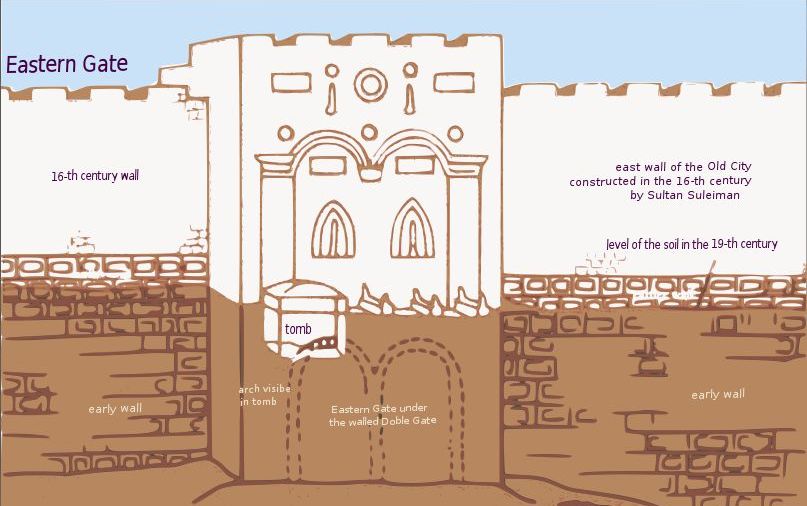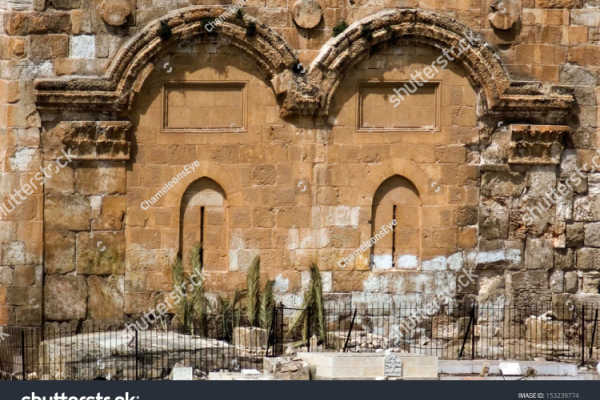
OFF THE BEATEN TRACK: The Gate of Mercy – Where the Messiah Enters Jerusalem

The Gate of Mercy, a.k.a the Shushan and Eastern Gate, is where the Messiah will enter Jerusalem and redeem Israel.
By Nosson Shulman, Licensed Tour Guide
“Be exceedingly happy, O daughter of Zion; Shout, O daughter of Jerusalem. Behold! Your king (Messiah) shall come to you. He is just and victorious; humble, and riding a donkey and a foal, the offspring of [one of] she-donkeys (Zechariah 9:9)”
“And you shall give it to Eleazar the kohen, and he shall take it outside the camp (via the Eastern Gate) and slaughter it in his presence (Number 19:3)”
“The he-goat shall thus carry upon itself all their sins to a precipitous land, and he shall send off the he- goat (via the Eastern Gate) into the desert (Leviticus 16:22)”
Today we are exploring one of the most significant (though unfrequently visited) sites in the country, the Gate of Mercy, which is now sealed but leads to the top of the Temple Mount.
What makes this site so important is not just because of its history, but also its future! That is because (according to Jewish tradition) this is where Mashiach (Messiah) will enter to redeem Israel.
The Gate is found on the eastern wall of Jerusalem’s Old City, which is by the far the oldest wall. Whereas most of the current walls surrounding the Old City are from the Ottomans in the 16th century, the visible bottom parts of the wall are from the Hasmonean period (circa 100 BCE), and the top parts are from the times of Herod (circa 20 BCE).
In the days of King Solomon (who built the First Temple), an eastern gate existed which led to the Temple Mount. It is believed to be close to the current gate, although it was destroyed by the Babylonians in 422 BCE (some historians say 586 BCE) along with the holy Temple. In 371 BCE, the Jews once again returned to Israel and rebuilt the Temple.
In 355 BCE after a wave Jewish immigration back to Israel, Nehemiah rebuilt the city walls of Jerusalem. This included the construction of the Shushan (Eastern) Gate, named after the capital city of Persia, the empire who ruled Israel at that time. The Eastern gate even had a design of Shushan on it. According to Jewish sources, this was ordered by Persia so that the people would remember that they were living under Persian rule, and not to rebel.
The gate led directly to the Temple Mount, and through it the High Priest lead the red heifer, an extremely rare cow, to the Mount of Olives.
Due to the Torah specifications of what constitutes a red cow, only nine have ever existed and in the days of Messiah, a 10th is to be found. The red heifer was slaughtered, with his remains being burned. The ashes of the animal would then be mixed with a special water, and then sprinkled on someone who had been impure (for example being near a corpse) in order to purify him.
This was an extremely important procedure, otherwise anyone who had ever been to a cemetery (or been in place where someone died while he was there) could not enter the Temple until they were purified (see Numbers 19 for more on the Red Heifer).
It was also through this gate on Yom Kippur (the holiest day of the year except for Shabbat) where the High Priest sent off the he-goat who had the lot on him which read “To Azazel”. The goat would be brought to Azazel, a mountain in the Judean Desert, and killed. This was a very important commandment and an essential aspect in the atonement service of Yom Kippur (see Leviticus 16).
The Temple was destroyed by the Romans in 70 CE. In the 7th century (some say the end of the Byzantine Empire, while others say the early Islamic period) a new gate (Mercy Gate) was built on top of the ruins of the Shushan Gate.

A diagram showing the older Shushan gate buried underground below the Mercy Gate. (Wikimedia Commons)
According to Jewish tradition, Mashiach will enter the city via the Mercy Gate and rebuild the Temple.
In 1541 the Ottoman Turks who had just finished building the (current) City Walls of Jerusalem, sealed the gate in order to prevent the Messiah from entering and redeeming Israel. (The fact that they invested so many resources for this, clearly indicates that they also believed in the coming of Messiah).
A Muslim cemetery was even placed there to prevent Elijah the Prophet, a Kohen (Priest) from heralding in Messiah (according to Torah law, a priest cannot enter a cemetery). Ironically, unbeknownst to the Turkish government at that time, a priest may enter a non-Jewish cemetery, so this graveyard does not hinder anything!

This Muslim cemetery was placed in front of the Mercy Gate to prevent Elijah from heralding in Messiah, although he could have entered anyway, as a priest can enter a non-Jewish cemetery! (Shutterstock)
On your next trip to Israel, a view of the Mercy Gate can definitely enhance your trip experience. May the holy Temple be rebuilt speedily in our days!
Nosson Shulman is a journalist and Licensed Tour Guide in Israel specializing in Biblical tours. To allow tourists to experience Israel during the Corona era, he created the new hit Israel tour video series, which brings Israel to the home of viewers by simulating actual tours. To check out his free sneak preview tour videos, click here. To view sample tour itineraries or to inquire about private tour opportunities with a personalized itinerary on your next trip to Israel, click here.
PLANT THE FIRST FRUITS OF ISRAEL AFTER THE SABBATICAL YEAR!
ISRAELI FARMERS NEED YOUR SUPPORT NOW
The Sabbatical Year (Shmita) is ending soon. Israeli farmers could not plant for an entire year – now they will plant DOUBLE! Order trees now and yours will be planted first. What a blessing to plant the first fruits of Israel!
“…I will ordain My blessing for you…”
(Leviticus 25:4,21)
DOUBLE THE PLANTING – DOUBLE THE BLESSING. ORDER YOUR FRUIT TREES TODAY!
The post OFF THE BEATEN TRACK: The Gate of Mercy – Where the Messiah Enters Jerusalem first appeared on United with Israel.
United with Israel

